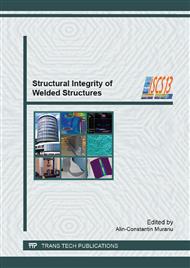p.1
p.7
p.19
p.25
p.33
p.41
p.49
p.54
State Analysis and Integrity of Welded Structures of the Upper Ring of the Turbine Runner Guide Vane Apparatus of Hydroelectric Generating Set A6 on Hydro Power Plant Djerdap 1
Abstract:
During the refurbishment of the hydroelectric generating set A6 on HPP Djerdap 1, for the state analysis and assessment of the level and causes of degradation of the structure of the vertical Kaplan turbine runner guide vane apparatus non-destructive tests and inspections, as well as destructive tests of base material and welded joints, have been carried out after 40 years of service. Results of non-destructive tests performed on welded joints are presented in this paper (magnetic particle and ultrasonic inspection), as well as results of destructive tests of the base material and welded joints (testing of tensile properties, impact testing, metallographic analyses of the structure). A large number of crack type line indications were detected by magnetic particle inspections, while the occurrence of partial penetration in roots of welded joints was detected by ultrasonic inspections, as well as lamellar tearing of the base material. Tensile properties of tested samples taken in longitudinal and transverse direction fulfilled the requirements of the standard with certain deviations, which does not stand for samples taken in z-direction with significantly lower values of contraction of the cross-section than minimum prescribed values, which proves that base material is not resistant to the occurrence of lamellar cracks. Metallographic tests performed on specimens taken from the base material in longitudinal and transverse direction showed that the microstructure is stripe-shaped and ferrite-pearlite with non-metallic inclusions of oxide, sulphide, silicate and aluminate type, while metallographic tests performed on specimens taken from welded joints showed that their microstructure is stripe-shaped and ferrite-pearlite with non-metallic inclusions of oxide type. A large number of micro-and macro-cracks were detected in the microstructure as well. Experimental tests enabled the determination of the causes of occurrence of lamellar tearing in base material and crack type defects in welded joints, while analytical calculation that refers to the stress state enabled integrity of welded structure of the upper ring of the turbine runner guide vane apparatus.
Info:
Periodical:
Pages:
7-18
Citation:
Online since:
September 2013
Price:
Сopyright:
© 2013 Trans Tech Publications Ltd. All Rights Reserved
Share:
Citation:


